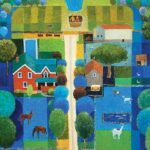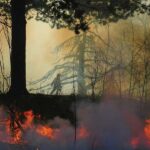
Bats are good neighbours, and they could use our help.
It’s easy to forget about bats, nighttime creatures that they are. Yet bats play an important role in the ecosystem, spreading seeds, pollinating plants, and saving farmers countless dollars by consuming agricultural pests. And bats are fascinating creatures in their own right.
For instance, bats are the only mammal capable of self-powered flight, an ability they’ve had for at least 50 million years. And they navigate and find their prey in the dark using echolocation, sending out sounds at frequencies too high for humans to hear. These sound waves bounce back to the bat. When a bat detects an insect it sends out a rapid series of calls to exactly pinpoint its prey, which then becomes its dinner.
Globally, there are about 1,400 species of bats, eight of which make their home in Ontario. In the Watershed region, the species that have historically been abundant include the tri-coloured bat, the northern long-eared bat and the little brown bat. The word historically is significant, because in recent decades bat populations have plummeted due to white-nose syndrome, a fungal disease that disrupts hibernation cycles, depriving bats of the stored energy they need to survive winter.
The good news is that some species may be on the rebound, and there are things we humans can do to help bats recover.
Dr. Christina Davy is an assistant professor at Carleton University’s Department of Biology, who has done field work on bats at Presqu’ile and Amherst Island. Watershed caught up to her by phone in the Ottawa area, where she was tagging tri-coloured bats in a maternity colony. She says that following a crash of 95 percent or more, the population of some species such as the little brown bat appears to have stabilized. Studies of surviving bats found that they have a different genetic profile that appears to give them resistance to white-nose syndrome.
“That’s really exciting,” she says.
If these surviving bats pass along their positive genetic characteristics, there’s a potential that future generations will also be resistant. “I remain cautiously optimistic,” says Dr. Davy.
Rebuilding bat populations will require time. Bats reproduce slowly, giving birth to only a single pup a year. Dr. Davy says, “recovery is now about supporting those populations.” The ongoing survival of bat populations requires maintaining their habitat, which in our region includes wide canopy deciduous trees for roosting and tree cavities for nesting. “Anywhere that’s warm and dry,” says Dr. Davy.
Although a bat house can’t reproduce all the benefits that natural habitats provide, it may provide a better home than your attic.
GO TO BAT FOR BATS
Building a bat house is something many of us can do to help these nocturnal creatures. Although a bat house can’t reproduce all the benefits that natural habitats provide, it may provide a better home than your attic. The online information that accompanies most bat house plans can teach us more about these unique animals, before we break out the saws and screwdrivers.
Picton resident and woodworking enthusiast, Brock Warner, began a relationship with bats by building a bat house that he installed on the side of his garage. He then realized he could make a bigger bat house if he had a better spot to put it. A location on the 62-acre Glenwood Cemetery on Macaulay Mountain fit the bill. “Because there are some low-lying marshy areas near the back of the cemetery, there are plenty of bugs.”
After doing research on designs, he constructed a “rocket box” bat house, about 5 feet tall, 12 to 14 inches on each side, with its interior divided into cavities. He mounted it on a pole in the cemetery grounds. The Glenwood Cemetery board supported the project, paying half the cost of materials. “They are very aware that when trees come down, that’s habitat loss,” says Warner.
Although placing a bat house in a cemetery seems a little close to Hallowe’en stereotypes, it in fact aligns with the Glenwood Cemetery’s community and environmental interests. Established in 1883, Glenwood is run by volunteers and offers services including natural green burials in a forest. “It’s like a little conservation area,” says Warner of the cemetery property. Building the bat house, he says, “was the start of a really nice relationship with them.” He now volunteers as a Glenwood Cemetery board member.
If you are interested in building a bat house as a fall and winter project, there are a few site considerations to think about. Bats like to be warm during their nesting season – April to June – so temperature is important. The Canadian Wildlife Federation recommends finding a site that gets at least 10 hours of sunshine daily. Bat boxes need to be mounted high, at least 12 feet off the ground, to deter predators. The side of a building or a pole offers more safety than a tree.
Bats require water on a nightly basis, so a site within a quarter mile of a water source such as a stream or pond is more likely to attract them. And they like the dark, so look for a location away from street lights or porch lights. When looking at bat house plans, bigger is better. Bats prefer to be in groups. A large, multi-chambered design will offer them more room and more stable temperatures than a smaller, single-chambered box.
Finally, bats need bugs to feed on, so consider adding native flowering plants, which attract more insects to your property than non-native varieties. Look for plants that bloom into the evening or through the night for optimum bat attraction. Consider yourself lucky if your bat house site includes a nearby native oak, which can host hundreds of different insect species including the moths that bats love to eat.
Even with optimum conditions it may take a while – perhaps a season or two – for bats to find your project. Resist the temptation to disturb your bat tenants by shining a light in the box to see if any are home. Instead, look for droppings below the accommodations you’ve provided as evidence they’ve moved in.
To see the rocket box plans Brock Warner used for his Glenwood Cemetery project, visit batcon.org. The Canadian Wildlife Federation has plans for a smaller bat house at:
Story by:
Norm Wagenaar




